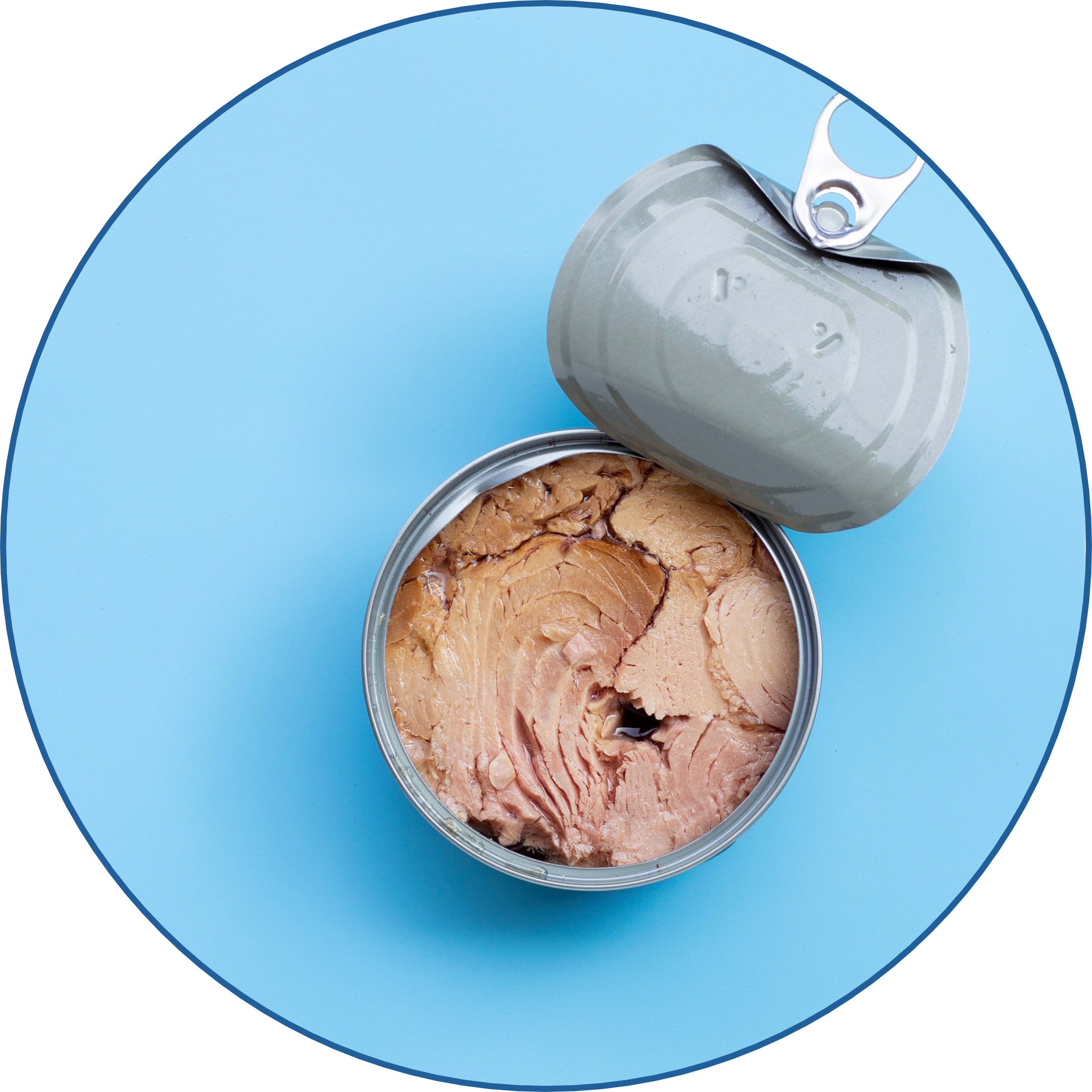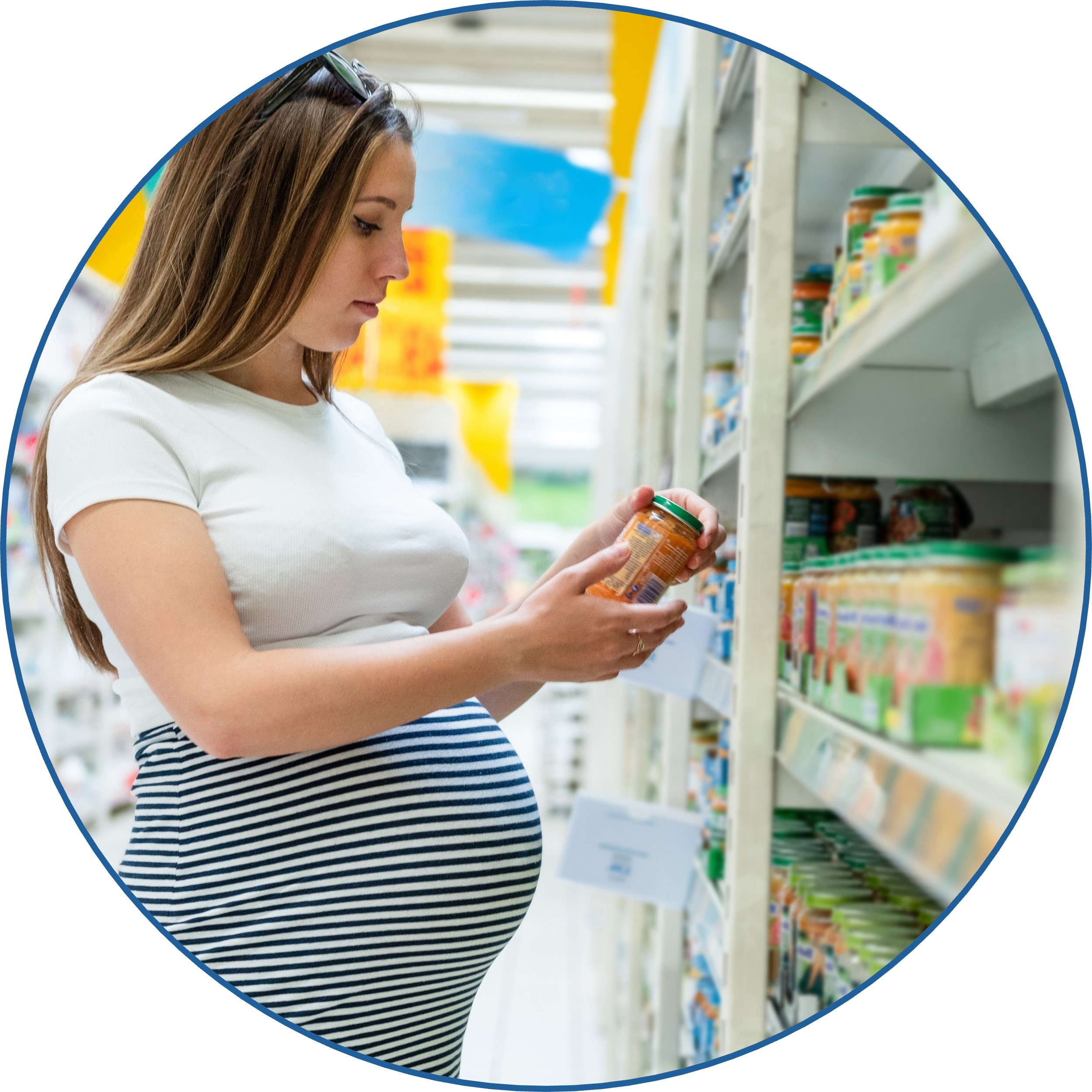USDA has made science-based updates to the WIC food packages – the foods and beverages WIC provides to participants to support their nutritional needs during important life stages and foster healthy growth and development.
For questions and answers about specific food categories, click on the images below
Food Package Basics
- What are the WIC food packages?
The WIC food packages provide supplemental foods designed to address the specific nutritional needs of income-eligible pregnant, breastfeeding, and non-breastfeeding postpartum individuals, infants, and children up to five years of age who are at nutritional risk.
WIC participants receive a monthly benefit from one of seven science-based food packages, according to their life stage nutritional needs. Participants then use their WIC electronic benefit transfer (EBT) card to buy the food and beverages in their package.
- What does it mean that the food packages are supplemental?
The WIC food packages are designed to fill nutritional gaps in participants’ diets by providing specific nutrients via specific foods and beverages. Except for infants under six months of age, the packages are not intended to provide all the foods and beverages a participant needs for a complete diet; rather, they’re intended to build on (i.e., supplement) what participants already eat and drink to provide a balanced and nutritious diet that supports healthy growth and development.
- How do the food packages meet participants' specific nutritional needs?
When each applicant applies for WIC benefits, a comprehensive nutrition assessment is conducted, and food packages can be individually tailored to meet participants’ needs. Substitutions, modifications, and/or eliminations of food types can be made to accommodate a participant’s special dietary needs or cultural and personal preferences. For example, a breastfeeding participant who is vegan may swap peanut butter for eggs, while another participant who is allergic to peanut butter could receive canned or dry beans as an alternative.
- Why did USDA update the WIC food packages?
The law requires USDA to conduct a comprehensive scientific review of the WIC food packages at least every ten years and update them, as needed, to reflect nutrition science, public health concerns, and cultural eating patterns. USDA is committed to ensuring current nutrition science informs Federal nutrition program standards and updating the WIC food packages is an important part of fulfilling that commitment.
- When were the WIC food packages last updated?
USDA last updated the WIC food packages in 2014, largely based on recommendations from the National Academies of Science, Engineering, and Medicine (NASEM) in a 2006 report.1
1The National Academies of Science, Engineering and Medicine (NASEM) is a congressionally chartered organization that provides independent, objective advice to inform policy. To date, NASEM has conducted two reviews of the WIC food packages, the first completed in 2006 and informing the food package revisions implemented in 2014, and the second completed in 2017 and informing the current changes.
- What type of scientific review did USDA conduct for this update?
In August 2014, FNS contracted with NASEM to conduct another scientific review of the WIC food packages and recommend changes in line with the nutritional status and food and nutrition needs of the WIC-eligible population. On Jan. 5, 2017, NASEM released their report, with numerous recommendations based on their approach to the food packages being a supplemental source of nutrients to the diets of WIC participants, among other considerations. FNS also considered the 2020-2025 DGA recommendations and FDA-EPA's 2021 advice about eating fish to ensure the final revisions reflected the most current nutrition science.
Food Package Changes
- How did USDA update the WIC food packages?
In November 2022, USDA published a proposed rule, Revisions in the WIC Food Packages, that considered:
- An independent scientific review completed by NASEM in 2017 with science-based recommendations for updating the WIC food packages to meet the nutritional needs of those eligible for WIC.
- The Dietary Guidelines for Americans, 2020-2025 (DGA), which included new recommendations specifically for life stages relevant to WIC – pregnancy, breastfeeding, infancy, and early childhood (under 2 years of age).
- The FDA-EPA’s 2021 Advice about Eating Fish.
- Program administration and the intent of the food packages, which are supplemental and designed to fill key nutritional gaps.
USDA received over 17,000 comments on the proposed rule during the 90-day comment period and considered this feedback in developing the final rule. The comments came from a variety of sources, including WIC state and local agencies, professional organizations and associations, advocacy groups, health care professionals, universities, members of congress, industry, participants, and the general public. A comprehensive summary of comments is publicly available.
- What's changing in the WIC food packages?
The changes align the food packages with the latest nutrition science and better support equitable access to nutritious foods during critical life stages by providing:
- More choices to ensure participants have access to essential nutrients that support healthy growth and development.
- More balance to address key nutritional needs and support healthy dietary patterns.
- More flexibility and variety to accommodate personal and cultural food preferences and special dietary needs.
- More support for individual breastfeeding goals to help establish and sustain long-term breastfeeding.
- How will participants benefit from these changes?
WIC is a powerful, evidence-based public health program with a long history of improving health and developmental outcomes for children. Through the WIC food packages, nutrition and breastfeeding education, and referrals, WIC is uniquely positioned as an effective tool to help reduce disparities in maternal and child health outcomes. With over 6.6 million women, infants, and children participating in WIC – and millions more eligible to participate – any changes we can make to better support their health will result in meaningful, long-lasting impacts for children and families.
- How do the changes support breastfeeding?
The changes provide more support for moms and babies across a wider range of breastfeeding levels so that breastfeeding is not an all or nothing choice when prescribing food packages by:
- Creating a separate and enhanced food package specifically for mothers who are mostly, but not exclusively, breastfeeding to align with their higher calorie needs.
- Adding flexibility to the amount of formula provided for partially breastfed infants to better support individual breastfeeding goals.
- Providing important nutrients that individuals who are breastfeeding need by offering all breastfeeding participants canned fish and more fruits and vegetables.
- How do the changes encourage participants to eat more fruits and vegetables?
The updated food packages provide broad access to the variety of key nutrients found in fruits and vegetables. The final changes encourage participants to eat more fruits and vegetables by increasing the cash-value benefit (CVB) amounts – allowing participants to buy and try more. The final changes also expand what participants can purchase through the CVB such as fresh herbs and larger package sizes of fresh produce.
- How do the changes support those with cultural or personal preferences and special dietary needs (such as food allergies or intolerances)?
The changes provide more flexibility, more variety, and more choice for both WIC-administering agencies and participants. These changes build on current accommodations for cultural and personal preferences and limited cooking and/or storage facilities, as well as for individuals with special dietary needs due to medical conditions, while still ensuring WIC foods provide participants with important and priority nutrients. These changes include:
- Adding more non-dairy substitution options for milk, such as plant-based options, and requiring lactose-free milk to be offered.
- Adding more whole grain options to include foods like quinoa, teff, wild rice, millet, corn meal (including blue), and whole wheat naan, which support wider personal and cultural food preferences and can accommodate wheat allergies.
- Significantly increasing the value of the fruit and vegetable benefit, giving participants more buying power and more flexibility to choose the produce they prefer and room to try those less familiar to them.
- Lowering the age at which parents and caregivers can substitute jarred infant fruits and vegetables with a cash value benefit for fruit and vegetables purchases from 9 months of age to 6.
Additional changes that support those with cultural or personal preferences, limited cooking and storage facilities, and special dietary needs such as food allergies or intolerances are summarized in the side-by-side.
- Did USDA get feedback on the changes to the WIC food packages?
Yes. Through the 90-day public comment period – starting when USDA published the proposed rule on Nov. 21, 2022 through Feb. 21, 2023 – USDA sought, received, and carefully considered robust feedback from diverse perspectives to inform the final rule and ensure this iteration of food packages best serves WIC participants. USDA appreciates and thanks all those who submitted public comments on the proposed rule. A comprehensive summary of comments is publicly available.
Adjusted Amounts
- Why do the changes reduce the juice amounts provided?
By law, WIC is designed to supplement diets and provide nutrients for healthy growth and development. It’s a science-based program that takes into consideration what participants already eat and drink and fills in nutritional gaps.
Research shows that child and adult participants are already getting enough juice in their diet. Prior to the final changes, the WIC food packages provided juice in amounts that were as much as 107 percent of the recommended daily limit as part of a healthy diet. The juice changes – about a half-gallon less each month on average - provide a more balanced amount that’s in line with nutrition science and supported by the American Academy of Pediatrics.
Additionally, the Dietary Guidelines emphasize whole fruits and vegetables, especially for young children. Juice is lower in fiber, a key nutrient that is widely under-consumed. Therefore, consistent with NASEM’s recommendations, USDA reduced juice amounts provided in the food packages and significantly increased the benefit amounts for fruit and vegetable purchases.
While limiting juice consumption is part of a healthy dietary pattern (as shown by the Dietary Guidelines’ s recommended limits), 100 percent juice can be part of healthy diet and is a convenient and cost-effective source of nutrients, particularly vitamin C. Therefore, the final rule provides postpartum participants with the same adjusted amount provided to children, pregnant, and breastfeeding participants.
USDA received nearly 2,000 comments in support of the reduction in juice amounts, including from the American Academy of Pediatrics which cited the importance of consuming juice in moderation and the benefits of whole fruits and vegetables, including dietary fiber.
- Why do the changes reduce the amount of milk provided?
By law, WIC is designed to supplement diets and provide nutrients for healthy growth and development. It’s a science-based program that takes into consideration what participants already eat and drink and fills in nutritional gaps.
Additionally, the Dietary Guidelines recommend consuming amounts of foods and beverages to meet nutrient needs while not exceeding calorie limits. Prior to the final changes, the WIC food packages provided 4-6 gallons of milk each month - amounts equal to as much as 128 percent of the recommended daily amount of dairy.
Recognizing the inconsistency with WIC’s supplemental intent, NASEM recommended reducing the milk amounts to provide a more balanced supplement to participants’ diets. USDA adopted NASEM’s recommendation, with the final changes reducing the milk quantities in the packages to 3-4 gallons each month, providing amounts between 71-96 percent of the daily recommended amount of dairy. As a result, WIC continues to provide access to and support milk consumption, which important contains nutrients such as calcium and vitamin D.
- Why do the changes eliminate cheese from the fully breastfeeding participant's food package?
Prior to the final changes, the food package for fully breastfeeding participants provided 119 percent of the daily recommended dairy amount and was the only food package to provide cheese as a separate category.
In alignment with NASEM’s recommendations and the Dietary Guidelines, the final changes remove cheese as a separate category to reduce saturated fat in this food package and provide more balance among the food groups. Cheese remains a partial substitution option for milk in all the child and adult food packages. Therefore, fully breastfeeding participants are still able to purchase cheese as part of their package.
- How is fish being included in the food packages?
The final changes add 6 ounces of canned fish to food packages for children (1 through 4 years) and allow canned light tuna, chub mackerel, salmon, sardines, and Atlantic mackerel for children.
The final changes also add 10 ounces of canned fish to food packages for pregnant and postpartum participants and 15 ounces for partially breastfeeding participants; and adjusts amounts for fully breastfeeding participants from 30 to 20 ounces.
Lastly, the final changes remove jack mackerel from the WIC-eligible canned fish varieties. The FDA and EPA currently do not have methylmercury data on the commercial canned fish product “jack mackerel” and do not include this product in their joint advice about eating fish.
Differences from the NASEM Recommendations
- Why are some changes in the final rule different from what NASEM recommended?
As with the last NASEM report (2006) and subsequent interim (2009) and final changes (2014) to the food packages, USDA made changes in both the 2022 proposed and 2024 final rules based on several factors, outlined in the respective preambles.
These factors largely include:
- Aligning changes with updated nutrition science that emerged since NASEM released their 2017 report, including publication of the 2020-2025 Dietary Guidelines for Americans;
- Ensuring administrative ease for WIC state agencies;
- Building on NASEM's recommendations to accommodate special dietary needs and increase variety and choice;
- Alignment with other federal nutrition program standards where practical and possible; and
- Considering public comments on the proposed rule.
- NASEM recommended all breakfast cereals be whole grain. Why are 75 percent of cereals required to be whole grain in the final rule?
The latest Dietary Guidelines note that nearly all Americans – 98 percent – do not meet recommendations for whole grain intake. In their 2017 report, NASEM recommended all cereals WIC provides meet the revised whole grain criteria (i.e., whole grain as the first ingredient) to better support the supplemental nutritional needs of WIC participants. The proposed rule, which included that recommendation, provided an opportunity for USDA to hear directly from WIC-administering agencies, participants, and other individuals and groups via the public comment process.
USDA carefully considered comments on all provisions, and while commenters supported the goal of increasing whole grain consumption, several also expressed concern about the increased burden on small vendors and reduced participant choice.
Among the goals of the final changes are to provide as much participant choice as possible while ensuring the changes reflect current nutrition science and deliver key nutrients. USDA acknowledges that consuming some non-whole grain cereal can contribute to delivering important nutrients for healthy development, including iron and folate. Therefore, USDA modified the provision in the final rule to require at least 75 percent of cereals that WIC state agencies authorize to have a whole grain as the first ingredient.
- NASEM provided recommendations for total sugar limits. Why does the final rule include added sugars limits?
Added sugars limits are more consistent with current dietary guidance and through public comment on the proposed rule, USDA received broad general support for the use of an added sugars limit versus a total sugars limit for yogurt and breakfast cereal.
While NASEM provided an added sugars limit for yogurt in its 2017 report, their final recommendation was for a total sugars limit given that FDA's regulation to include added sugars on the Nutrition Facts label was not yet implemented. Thus, NASEM could not review and compare the suggested added sugars limits against marketplace availability, a core tenet of their charge in their report. However, FDA's labeling requirement for added sugars is now in place. The new added sugars limit of ≤ 16 grams per 8 ounces of yogurt aligns with NASEM’s suggested limits, which ranged from 11-18 grams of added sugars per 8 ounces depending on fat content.
To maintain consistency in WIC’s nutrition standards, the final changes also provide an added sugars limit for breakfast cereal – revising the limit per dry ounce from ≤ 6 grams of total sugars to ≤6 grams of added sugars.
Through public comment on the proposed rule, USDA received broad general support for the use of an added sugars limit versus a total sugars limit for yogurt and breakfast cereal. In addition, USDA recognizes the value in maintaining consistency with other federal nutrition programs such as the child nutrition programs, as is practical and in alignment with programs’ legislative intents and operations.
- NASEM's recommendations did not include allowing nut and seed butters as a substitute for peanut butter. Why are these products WIC-eligible substitutions for peanut butter in the final rule?
Per the 2020-2025 Dietary Guidelines for Americans (DGA), which came out after NASEM’s recommendations, nut and seed butters are nutritionally equivalent to peanut butter. The DGA include all nut and seed butters within the subgroup of nuts, seeds, and soy products.
NASEM did not specifically recommend adding or prohibiting alternative nut and seed butters as substitutions for peanut butter. However, the change is consistent with current nutrition science and the overall intent of NASEM's recommendations to support the special dietary needs (e.g., allergies) of WIC participants.
Implementation
- When do WIC state agencies need to implement the changes?
While state agencies may begin implementing provisions, state agencies must implement the provisions within 24 months from the publication date, with some exceptions.
- State agencies must implement the increased CVV amounts no later than 60 days from the publication date of the final rule.
- For state agencies that authorize yogurt, they must implement the vitamin D requirement for yogurt within 36 months from the publication date of the final rule.
- How will the final changes affect the current cash-value benefit (CVB) amounts?
Based on appropriations legislation (PL 118-42), FY 2024 CVB amounts for purchasing fruits and vegetables are currently $26 for child participants, $47 for pregnant and postpartum participants, and $52 for mostly and fully breastfeeding participants. Therefore, all WIC state agencies are currently in compliance with the 60-day implementation deadline for the final changes to the CVB amounts. USDA FNS will provide adjusted inflation amounts for FY 2025 in a policy memorandum in the summer of 2024.
- Can WIC state agencies implement the changes early?
Yes, and WIC state agencies are encouraged to implement the final changes before any of the implementation deadlines, so long as:
- For each participant category, WIC state agencies must issue food benefits based on the new food package in its entirety or the current food package. For example, a WIC state agency may not add fish to the current foods and quantities available in the children’s food package and make none of the other required changes to the children’s food package.
- WIC state agencies must also issue the new WIC food packages throughout the entire state agency service area to minimize participant and vendor confusion.
- Can WIC state agencies phase in implementation of different food packages?
Yes. WIC state agencies may phase in the new WIC food packages on a participant category basis. For example, all required changes to food packages for children ages 1-4 years may be implemented on a schedule different and separate from changes to food packages for pregnant participants.









